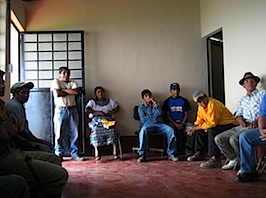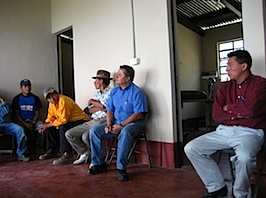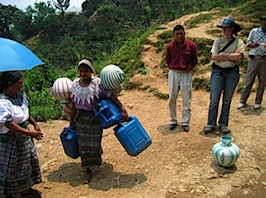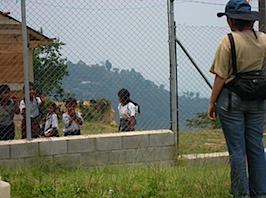 We’ve talked about Quixabaj before- it’s the third Health Post we work at. It’s so far away and hard to get to that we only go there for a few days every two months, and frankly, we can’t really get much done. We feel bad about this, and have been petitioning our boss at the Peace Corps to place a volunteer there when the next training group graduates in August. The people of Quixabaj deserve it; on one hand, they’re wracked with terrible poverty and there is a MOUNTIAIN of potential development work to be done; and on the other hand, they have a good work ethic and the leaders are willing to collaborate with Peace Corps volunteers. It’s a perfect opportunity. Emily and I, however, can’t give them the support they need. Since we don’t live there, we have to spend and entire day’s travel to get there, a day to get back, and while we’re there we don’t have the same community relationship as in our village.
We’ve talked about Quixabaj before- it’s the third Health Post we work at. It’s so far away and hard to get to that we only go there for a few days every two months, and frankly, we can’t really get much done. We feel bad about this, and have been petitioning our boss at the Peace Corps to place a volunteer there when the next training group graduates in August. The people of Quixabaj deserve it; on one hand, they’re wracked with terrible poverty and there is a MOUNTIAIN of potential development work to be done; and on the other hand, they have a good work ethic and the leaders are willing to collaborate with Peace Corps volunteers. It’s a perfect opportunity. Emily and I, however, can’t give them the support they need. Since we don’t live there, we have to spend and entire day’s travel to get there, a day to get back, and while we’re there we don’t have the same community relationship as in our village.
Our wishes were granted this week. Basilio (our boss) and Makali (the security chief at Peace Corps Guatemala) drove all the way out here to see Quixabaj, meet the village leaders, and evaluate it as a future site. It’s a big committment for both the town and the Peace Corps, so they wanted to do it right. They invited Emily and I along, since we are the face of Peace Corps in this region. They also invited several native Q’anjob’al speakers. Aurelio, our counterpart form the Ministry of Health, came to help with translation because it was he who officially invited the Peace Corps. Manuel Jesus and Don Tomax, two of the leaders from our village, came to tell the leaders of Quixabaj about how great a deal it is to have the Peace Corps in your town. Manuel and Tomax are interested in helping their fellow village (the Q’anjob’al Mayans are a very socially conscious people), but I also have this amusing suspicion that they want Quixabaj to have their own volunteers so that we can do more work in our own village. Heh.
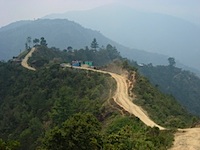 We all piled into two Peace Corps jeeps and made an early start. The weather was great, and the trip only takes two hours in a private jeep (as opposed to four while riding in the back of a 4×4 with 20 Guatemalans). Basilio and Makali got to really appreciate how tough a journey it is, though Makali pointed out that from a security standpoint, he was not too concerned about that. If a volunteer breaks a leg or something in a really remote place, the locals are usually good about throwing you on a horse or something and getting you out. Sounds pretty Indiana Jones, but it’s true: our villagers would to whatever had to be done to take care of us, and I am certain that the Quixabaj folks would do the same.
We all piled into two Peace Corps jeeps and made an early start. The weather was great, and the trip only takes two hours in a private jeep (as opposed to four while riding in the back of a 4×4 with 20 Guatemalans). Basilio and Makali got to really appreciate how tough a journey it is, though Makali pointed out that from a security standpoint, he was not too concerned about that. If a volunteer breaks a leg or something in a really remote place, the locals are usually good about throwing you on a horse or something and getting you out. Sounds pretty Indiana Jones, but it’s true: our villagers would to whatever had to be done to take care of us, and I am certain that the Quixabaj folks would do the same.
Once we arrived, we met with the village leaders in the lobby of the Health Center. Basilio has this uncanny ability to immediately engage and beguile Guatemalans. Part is his voice, but part is some odd mental power. He started the meeting out pretty aggressively, in a way only he could get away with.
“So,” he began. “Why is there only one woman here?”
The leaders hummed and hawed a bit, but the point was made. Peace Corps is about change. He then segued into other things: what are the biggest concerns the leaders have about Quixabaj, what aid have they received in the past, how would the people react to having gringoes living amongst them. Don Tomax and Manuel gave testimonials about how much they like having their volunteers. Emily got up and reminded the Quixabaj elders that they won’t be losing our support, and we will still be available to advise a permanent volunteer should they get one. The meeting went on for about an hour, but by the end, everyone felt pretty optimistic about a long-term arrangement.
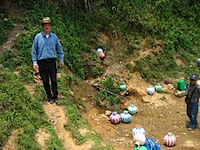 We then broke, with some of us staying in the health center to hash out details, others going down the mountain to see the town’s spring. Of the many problems they have on their plate, water is probably the biggest issue in Quixabaj. This spring shown here puts out a little less than a gallon per minute (click on the picture to the right to see a closeup of Makali and the spring), and serves a third of the town. Several hundred people. Women start lining up at 2am to fill their jugs, then haul them back up hill to their houses. A girl with jugs showed up when we were standing around talking about ideas to improve the situation, and I took her picture. Without asking. That’s a no-no and I know better, but I just forgot. Luckily, there was a lingering sense of excitement about our presence, and nothing came of it.
We then broke, with some of us staying in the health center to hash out details, others going down the mountain to see the town’s spring. Of the many problems they have on their plate, water is probably the biggest issue in Quixabaj. This spring shown here puts out a little less than a gallon per minute (click on the picture to the right to see a closeup of Makali and the spring), and serves a third of the town. Several hundred people. Women start lining up at 2am to fill their jugs, then haul them back up hill to their houses. A girl with jugs showed up when we were standing around talking about ideas to improve the situation, and I took her picture. Without asking. That’s a no-no and I know better, but I just forgot. Luckily, there was a lingering sense of excitement about our presence, and nothing came of it.
On the trip back, we discussed the meeting. Much to my relief, Basilio and Makali agree: this site is a winner, and definately worth making into a Peace Corps post. But he popped a suprise on me: in breaking with a long-standing tradition, he wants to place TWO volunteers in the site! It makes sense; it is very remote, they will likely need that kind of support network, and there is more than enough work to keep two people busy. Also, the new Quixabaj volunteers will have to be selected carefully. To that end, Basilio wants Emily and I to do a presentation to the new trainees in June and interview any volunteers. Then, when they start in August, we are to accompany them to Quixabaj and help them for the first week or so to make sure they integrate smoothly. Whoever these two adventurous people are, they are definitely going to get the “60s Peace Corps experience”, maybe even more than Emily and I did. Should be exciting.
